COVER STORY
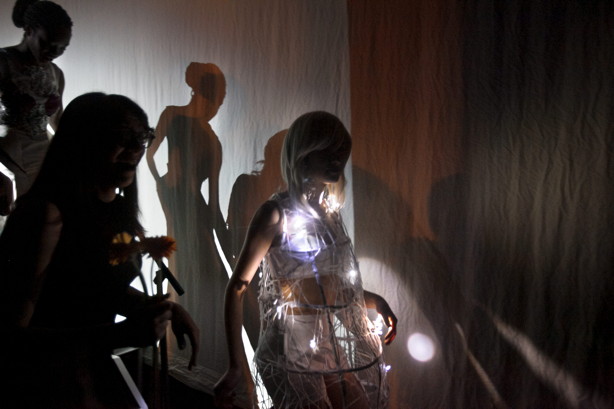
Scene from the Cornell Fashion Collective runway show. Photo: University Communications Marketing.
Eureka! That magic moment of discovery
Science fiction writer Isaac Asimov once said, "The most exciting phrase to hear in science, the one that heralds new discoveries, is not 'Eureka!' but 'That's funny …'" True, new ideas don't always hit us with the drama of displaced bathwater rising, as in the exclamation attributed to Greek mathematician Archimedes ("Eureka" means "I have found it!"). In fact, ideas are sometimes not discoveries at all, but compromises or collaborations or slowly dawning truths. Here are some recent Cornell ideas that span inspired revelation, quirky suggestion, counterintuitive supposition and the culmination of a lifetime of careful study.
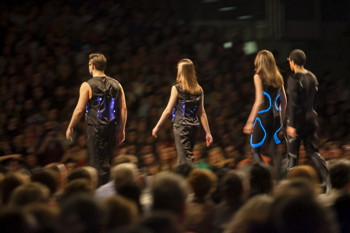
Scene from Cornell Fashion Collective runway show. Photo: University Communications Marketing. See larger image
1. lighting the runway
At the 30th Cornell Fashion Collective runway show April 12, fashion aficionados glimpsed clothes of the future – sleek laser-cut bodysuits and 3-D printed glasses lined with blue LEDs and electroluminescent wire and tape. The four pieces, developed by fiber science undergraduate Eric Beaudette and Ph.D. student Lina Sanchez-Botero with support from professors Juan Hinestroza and Huiju Park and Toronto-based Myant Capital Partners, imagine "a time when humans and our computers will be more closely integrated," Beaudette says.
2. beating metastasis with an army of killer white blood cells
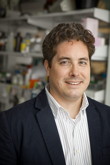
Michael King. See larger image
Most cancer deaths – about 90 percent – are related to metastasis, which spreads malignant cells throughout the body. But as Michael King, professor of biomedical engineering, explains, "now we've found a way to dispatch an army of killer white blood cells that cause apoptosis – the cancer cell's own death – obliterating [cancer cells] from the bloodstream. When surrounded by these guys, it becomes nearly impossible for the cancer cell to escape."
In January, King and his colleagues published a research paper in the Proceedings of the National Academy of Sciences. The engineers combined a therapeutic protein with an adhesive protein that sticks to leukocytes – white blood cells. When a cancer cell comes into contact with the protein in the bloodstream, it kills itself.

View of metastasis in the bloodstreamage. Image: Michael King. See larger image
King has been conducting studies since 2005, when he tried to scrub blood using a blood-contacting device outside the body. His "eureka" moment occurred a year after moving to Cornell, in 2009, when he decided to "flip the geometry" to see the results of wiping out the cancer from within the bloodstream using nanoparticles.
While at Cornell, King and his colleagues treated cancer cells with the proteins in saline and found a 60 percent success rate in killing the cancer cells. Once the proteins were added to a flowing blood model that mimics human-body conditions, the success rate soared to 100 percent.
Since this new research was published, new mouse trials are underway to test the therapy for prostate cancer. Breast cancer and lung cancer mouse trials will start this summer.
King's colleagues include Chris Schaffer, associate professor in biomedical engineering; Michael Mitchell, a Cornell doctoral candidate in the field of biomedical engineering; Elizabeth C. Wayne, a Cornell doctoral student in the field of biomedical engineering; and Kuldeepsinh Rana, Ph.D. '11.
– Blaine Friedlander
3. algae promise greener energy
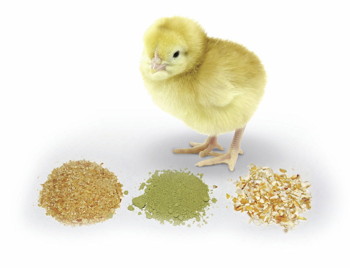
Chick with different feedstock choices. Image: Provided. See larger image
It might be green, but is it a moneymaker?
Multidisciplinary Cornell research teams have increased the commercial attractiveness of algal biofuel, overcoming hurdles that have delayed private-sector use of this promising green fuel.
One idea being explored is to develop high-value coproducts at the same time as the algal fuel. Animal scientist Xingen Lei is doing just that. With a new $5.5 million USDA grant to further research launched by Atkinson Center for a Sustainable Future seed funding, he is producing a nutritious animal feed from algae for broiler chickens, laying hens and weanling pigs. According to Lei, the animals like the literally and figuratively green alternative to their normal diet.
Also working with algal biofuel, Charles Greene, professor of earth and atmospheric sciences, and his research team parlayed a 2011 Rapid Response Fund award into an international algal biofuel partnership funded by a $9 million grant from the U.S. Department of Energy. Algae can produce far more biomass and oil per acre annually than the most productive terrestrial energy crops.
– Sheri Englund
4. holistic and smarter IQ tests
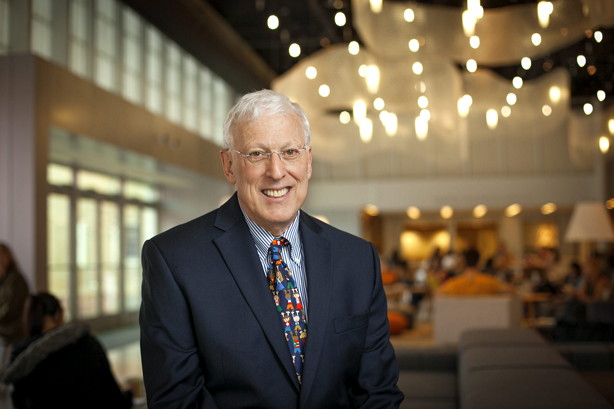
Robert Sternberg. Photo: University Communications Marketing
Saddled with test anxiety, Cornell psychologist Robert Sternberg "failed miserably" on IQ tests as a boy, he recalls. "The school psychologist who gave the tests looked scary, and I would freeze up. Of course, I did poorly. My teachers thought I was stupid. I thought I was stupid. Each year in early elementary school, I did a little worse."
Sternberg eventually overcame his fears, which have fueled one of his life's passions: constructing better intelligence measures. Now a professor of human development in the College of Human Ecology, Sternberg has traveled to remote locations in Africa, Asia, Alaska and elsewhere to develop alternatives to the SAT, ACT and other traditional tests of intelligence.
Traditionally, psychologists believed intelligence could be measured similarly to how a yardstick measures height – as basic mental skills that could be quantified. But Sternberg's research suggests a more holistic view that includes "creative, practical, wisdom-based and ethical skills" that reflect our ability to succeed in our social and cultural contexts.
Working with the Luo people of Kenya, Sternberg and colleagues assessed children's knowledge of natural herbal medicines used in the home. They theorized that if traditional academic measures are an overall indicator of intelligence, children who scored higher on such tests would also excel on tests of local knowledge. However, they found the opposite: For the Luo, having more academic knowledge was not adaptive to life success – local knowledge was. In isolated parts of Alaska and Russia, they made similar discoveries.
– Karene Booker
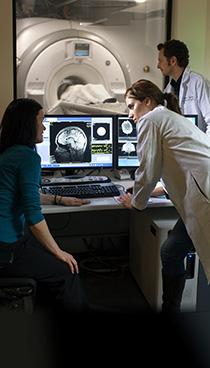
Cornell MRI Facility in Martha Van Rensselaer Hall. Photo: University Communications Marketing. See larger image
5. the view on shopping sprees from within an MRI
Since opening last year, the Cornell MRI Facility in Martha Van Rensselaer Hall has been a hotbed for unexpected research collaborations, none perhaps more novel than a partnership between neuroscientist Nathan Spreng and fashion design and management researcher Tasha Lewis, both in the College of Human Ecology.
The pair this spring began exploring the biological basis for the popular notion of "retail therapy" – the idea that shopping sprees brighten our outlook.
Lewis hopes she and Spreng could also use the MRI scanner to explore how consumers think about sustainable fashion, another research interest of hers. As with foodies wanting to know about their meal's origins, fashionistas demand to know where and under what conditions a garment was produced.
Spreng, a neuroscientist whose work includes searching for biomarkers to improve early diagnosis of Alzheimer's disease, says the facility enables other promising partnerships. He and Peter Doerschuk, professor of biomedical engineering, are developing new methods to view interactions between brain regions in ways never before seen by functional MRI scans. And Cornell linguistics professor John Hale has contacted Spreng to examine the biological basis for speech.
– Ted Boscia
6. have detector. will investigate.
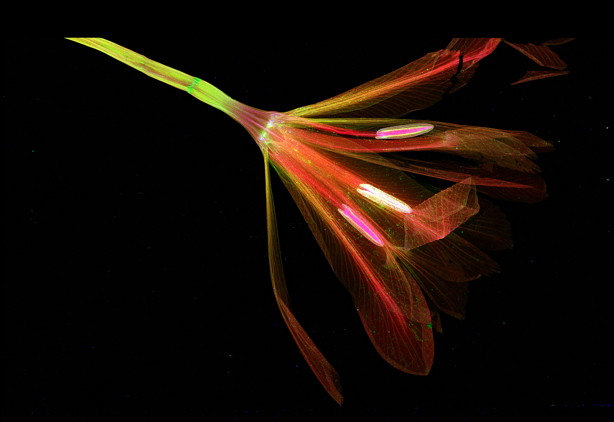
X-ray detector image of accumulation of potassium in the anthers of an iris. Image: Arthur Woll.
Operators of a new X-ray detector at the Cornell High Energy Synchrotron Source (CHESS) had hoped that their March dry run of the device, "Maia," would produce some usable data.
They got that and more. The stunning, high resolution and at times surprising images of ferns, beetles and other objects offered a sneak peek into never-before-seen science.
Maia is an energy-dispersive X-ray fluorescence detector. It builds a pixel-by-pixel digital image of X-ray wavelengths, like chemical fingerprints, emanating from the sample. All this at blazing speed, thanks to Maia's ability to process tens of thousands of photons in milliseconds, explains Arthur Woll, CHESS staff scientist.
Bug wings, ferns and feathers examined with Maia so far hint at a bigger role fluorescence detection could play in biological fields.
Take a fern leaf, in which Maia detected potassium, calcium and manganese. Such a striking presence of manganese near the tips of fern veins has never been reported before – a complete surprise to Karl Niklas, professor of plant biology. So, too, was the accumulation of potassium in the anthers of an iris (see image). The technique, Niklas says, could open up a "whole new view" of plant mineral nutrition.
– Anne Ju
7. stop campaigning -- (or, at least don't wear yourself out)
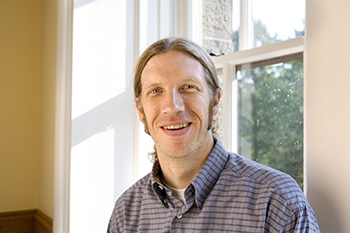
Peter Enns. Photo: University Communications Marketing See larger image
Research from Peter Enns, assistant professor of government, shows that all the money candidates spend on campaign propaganda might not do a thing to sway voters.
Enns analyzed responses from the National Annenberg Election Survey, which is conducted each day of the presidential campaign, and found that voters are much more concerned with "fundamentals" – economic conditions, approval of the incumbent president, partisanship and demographic interests – than campaign propaganda, except very early in campaigns.
"Our results suggest that the campaign plays a much smaller role with these fundamentals than previously thought," Enns says. "This conclusion does not, however, mean that campaigns don't matter. … Looking ahead to 2016, we don't need to wonder if the campaign will get voters to rely on the fundamentals – most can (and will) do this on their own. The real question is whether the campaign (or other events) will get voters to deviate from the fundamentals."
– Kathy Hovis
<<View entire story as one page>>